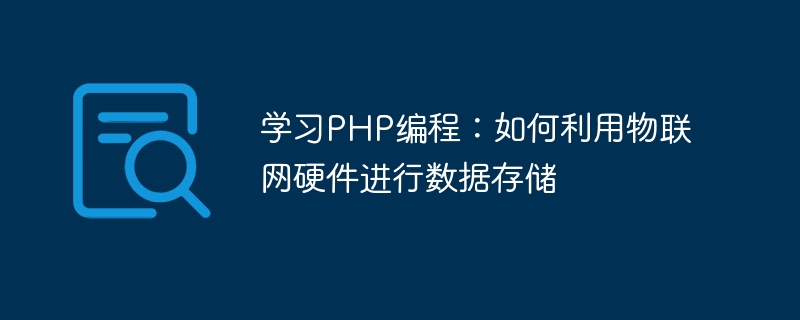Home >Backend Development >PHP Tutorial >Learn PHP Programming: How to Leverage IoT Hardware for Data Storage
Learn PHP Programming: How to Leverage IoT Hardware for Data Storage
- 王林Original
- 2023-09-11 13:22:41925browse

Learn PHP programming: How to use IoT hardware for data storage
With the development of IoT technology, more and more devices and sensors are connected to the Internet , providing us with a large amount of data. How to efficiently store and manage this data has become an important issue. As a powerful programming language, PHP provides a wealth of functions and tools that can help us implement data storage for IoT hardware.
First of all, we need to choose the appropriate IoT hardware device. There are many types of IoT hardware on the market today, such as sensors, microcontrollers, smart home devices, and more. Buy the right hardware devices based on your needs, and make sure they support the protocol for communicating with PHP, such as HTTP or MQTT.
Next, we need to write PHP code to communicate with IoT hardware devices. PHP provides a series of functions and classes that can easily interact with hardware devices. For example, we can use the cURL library to send HTTP requests, or the Mosquitto library to implement communication with IoT Message Queuing (MQTT).
In the PHP code, we need to first establish a connection with the IoT hardware device. This usually requires providing information such as the device's IP address, port number, and certificate. Once the connection is successful, we can send instructions to the device, obtain sensor data or send control commands to the device.
After we successfully obtain the sensor data, the next step is to store the data. There are many ways to store data in PHP, such as using a database, file system or in-memory cache. Choosing the right storage method depends on the needs and size of the project.
If the data volume of the project is small, we can choose to use the file system to store the data. PHP provides some functions and classes, such as file_put_contents and file_get_contents, to conveniently operate files. We can save the sensor data obtained each time as a file, or write the data line by line into a CSV file.
However, if the project has a large amount of data or requires persistent storage, we need to use a database to store the data. PHP supports multiple types of databases, such as MySQL, SQLite, MongoDB, etc. We can use PHP database extensions, such as mysqli or PDO, to operate the database.
Before data storage, we need to design and create database tables. The structure of the table should correspond to the attributes of the sensor data to facilitate subsequent data insertion and query operations. In PHP, we can use SQL statements to create tables and perform data operations. For example, use the CREATE TABLE statement to create a table, use the INSERT statement to insert data into the table, and use the SELECT statement to query data.
By using PHP's database extension, we can easily perform various database operations. Whether it is inserting data, querying data or deleting data, PHP provides a wealth of functions and classes to help us complete these tasks. We can also use prepared statements to avoid security issues like SQL injection.
In addition to the above storage methods, we can also consider using memory cache to improve the performance of data storage and query. PHP provides some extensions, such as Redis and Memcached, which can store data in memory to improve data access speed.
In summary, learning PHP programming can help us use IoT hardware for data storage. By choosing the right hardware device, writing communication code with the device, and choosing the right data storage method, we can efficiently store and manage data from IoT hardware. Taking advantage of the advantages and functions of PHP, we can exert greater creativity and value in the field of IoT.
The above is the detailed content of Learn PHP Programming: How to Leverage IoT Hardware for Data Storage. For more information, please follow other related articles on the PHP Chinese website!

